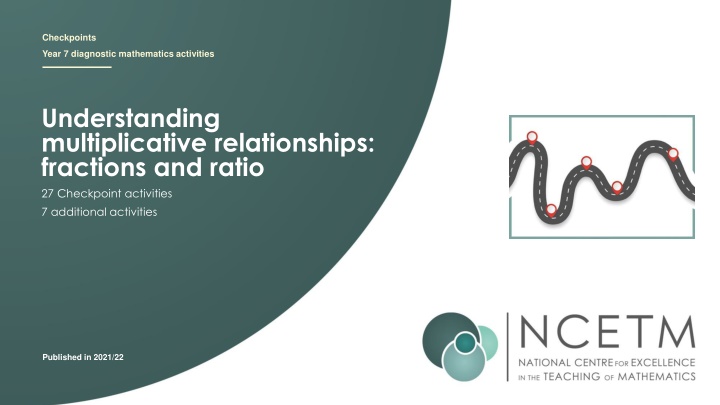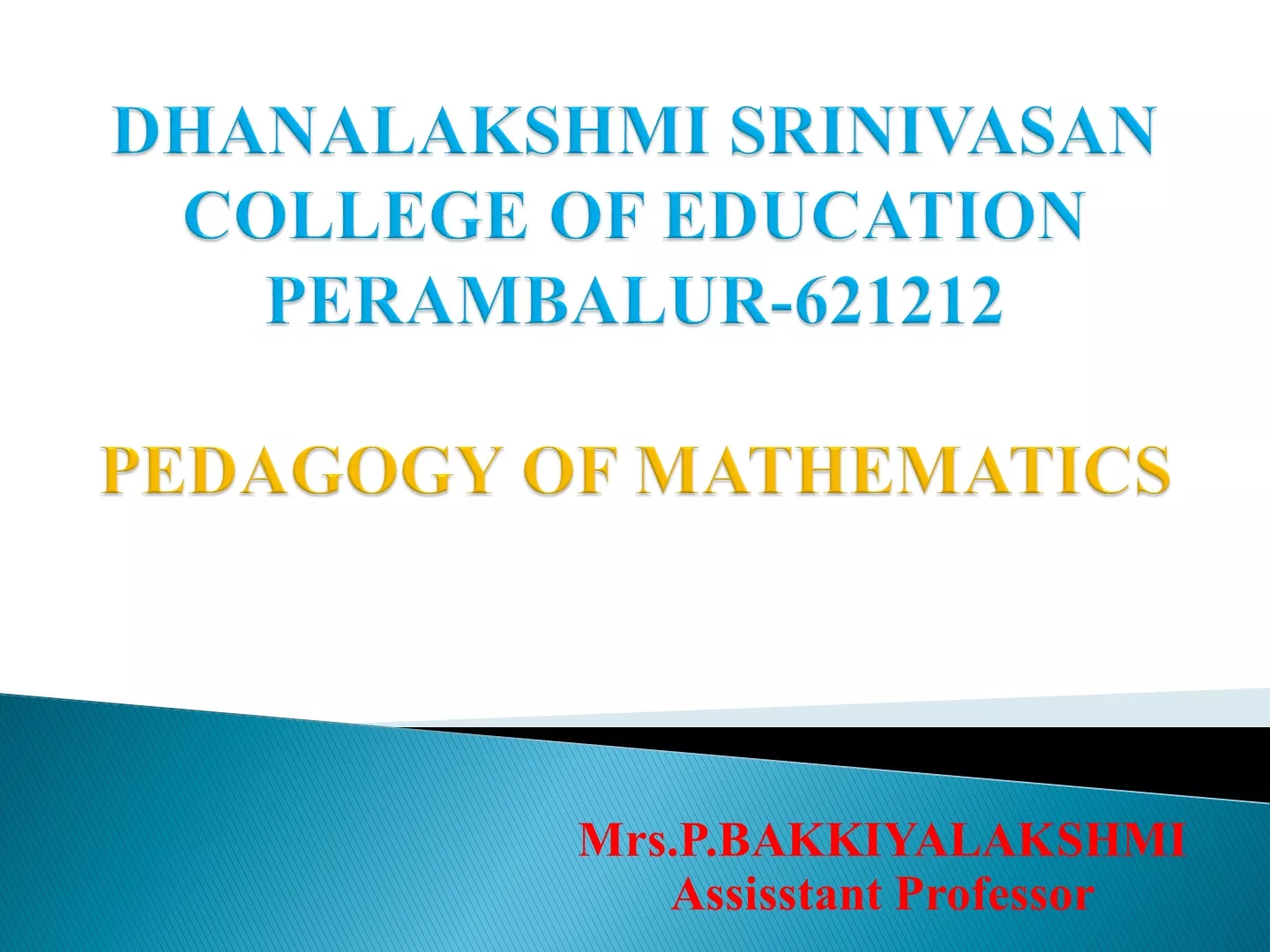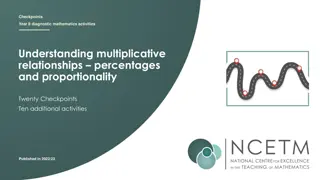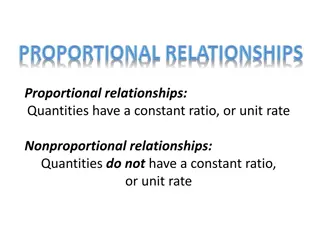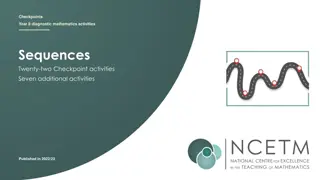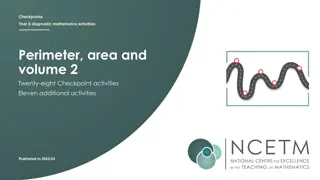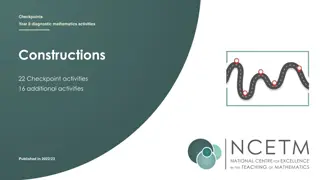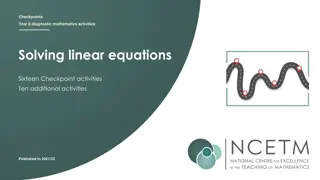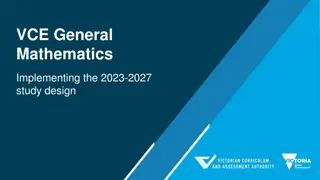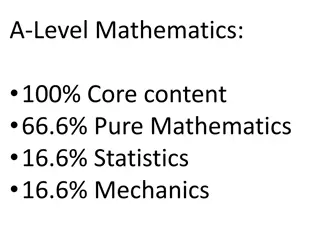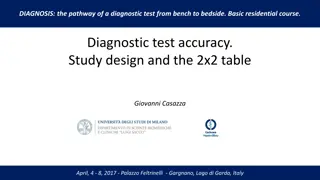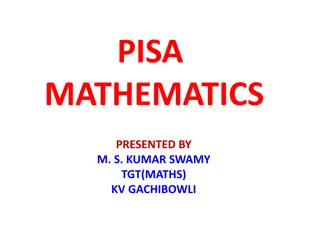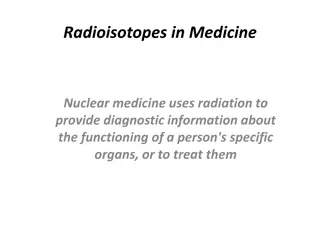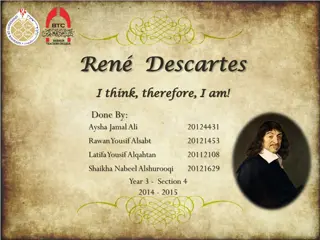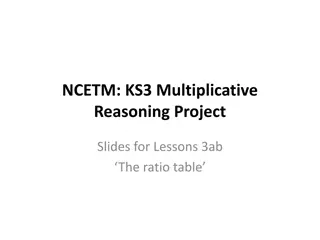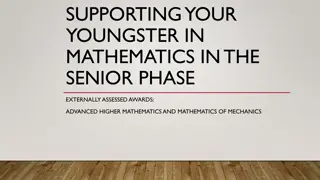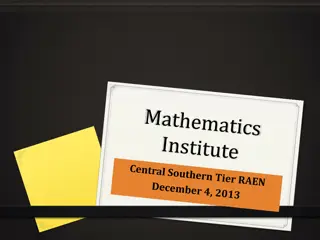Diagnostic Mathematics Activities for Understanding Multiplicative Relationships
Explore a series of checkpoint activities focused on fractions, ratios, and multiplicative relationships in mathematics. The checkpoints cover various topics such as pay rises, multiplication squares, true or false statements, and examples of multiplicative relationships. Engage in thought-provoking scenarios and challenges to enhance your understanding of mathematical concepts.
Download Presentation

Please find below an Image/Link to download the presentation.
The content on the website is provided AS IS for your information and personal use only. It may not be sold, licensed, or shared on other websites without obtaining consent from the author.If you encounter any issues during the download, it is possible that the publisher has removed the file from their server.
You are allowed to download the files provided on this website for personal or commercial use, subject to the condition that they are used lawfully. All files are the property of their respective owners.
The content on the website is provided AS IS for your information and personal use only. It may not be sold, licensed, or shared on other websites without obtaining consent from the author.
E N D
Presentation Transcript
Checkpoints Year 7 diagnostic mathematics activities Understanding multiplicative relationships: fractions and ratio 27 Checkpoint activities 7 additional activities Published in 2021/22
Checkpoints 19 Checkpoint Underpins Code 1: Pay rises 2: Multiplication square 3: Multiply 12 4: Products of 8 3.1.1 and 3.1.2 5: True or false? Multiplicative relationships 6: Muddy map 7: Playback 8: Pie charts 9: What s best? *This three-digit code refers to the statement of knowledge, skills and understanding in the NCETM s Sample Key Stage 3 Curriculum Framework (see notes below for more information).
Checkpoints 1017 Checkpoint Underpins Code 10: Splitting bars 11: Strategies 12: Same and different calculations 13: Nine-tenths or minus ten Fractions as an example of multiplicative relationships 3.1.3 14: Same and different bars 15: Fifteen 16: Savings 17: Clocks *This three-digit code refers to the statement of knowledge, skills and understanding in the NCETM s Sample Key Stage 3 Curriculum Framework (see notes below for more information).
Checkpoints 1827 Checkpoint Underpins Code 18: Shades of orange 19: Dough 20: Imperfect meringues 21: Flowers 22: Bunches of flowers Ratio as an example of multiplicative relationships 3.1.4 23: Running 24: How many times? 25: Chocolates 26: Unequal shares 27: Euros *This three-digit code refers to the statement of knowledge, skills and understanding in the NCETM s Sample Key Stage 3 Curriculum Framework (see notes below for more information).
Multiplicative relationships Checkpoints 1 9
Checkpoint 1: Pay rises Carol earns 4000 per month. She gets a pay rise, so she earns 4500 per month. Richard earns 400 per month. He gets a pay rise, so he earns 800 per month. Who has the best pay rise? What do you think is a fair pay rise for Carol, if Richard s pay increases from 400 to 800 per month? Is 4500 fair or should it be a different amount? Explain your answer.
Checkpoint 2: Multiplication square This is a multiplication square. It s been extended in each direction. How many of the missing numbers can you fill in? Create another column that could go in between the two extra columns given.
Checkpoint 3: Multiply 12 a) 12 + 12 + 12 + 12 = 12 ___ b) 12 + 12 + 12 + 6 = 12 ___ 12 + 12 + 12 + __ = 12 31 c) 4 __ + __ + __ + __ = 12 31 d) 3 What other similar calculations can you write with 3 and a bit 12s?
Checkpoint 4: Products of 8 The arrows point to the products. What are the missing values? 16 17 18 19 20 21 22 23 24 c) b) a) 8 __ 8 __ 8 __ d) 8 __ e) 8 __ 8 __
Checkpoint 5: True or false? Najma says, Write any numbers you like in the blue boxes, and I ll be able to write a number in the red box so that the multiplication is correct. = Is Najma correct? Give some examples to support your answer. Would Najma be correct if the multiplication symbol was a division symbol? Why or why not?
Checkpoint 6: Muddy map Bennie is out hiking. His map got muddy so he can t read all of the scale! a) Fill in the missing numbers. b) Bennie measures that his campsite is 5 cm away on the map. How many kilometres will he need to walk to get there? c) He plans to stop at a church that is 10 km away. How many centimetres will this be on the map? d) Bennie knows that the nearest town is 40 km away from the church. How many centimetres will this be on the map? e) Bennie walks along a path that is 4 km long. How many centimetres will this be on the map? Bennie can walk at a pace of 6 km per hour. How long will it take him to walk each of the routes in parts b) to e)?
Checkpoint 7: Playback Yuvraj is watching a video. The video is 60 minutes long when watched at the normal speed. Share Playback Speed > Playback Speed > > 0.5 1.0 1.25 1.5 2.0 3.0 a) If Yuvraj changes the playback speed to 2.0 , how long will it take to watch it all? b) How long will the video last if he watches it at 3.0 ? c) How long will the video last if he watches it at 0.5 ? If the video lasted 40 minutes, what playback speed did he choose? How do you know?
Checkpoint 8: Pie charts Samira records the different ways that students travel to school. She records her results in a pie chart. a) Which of these are possible tables for her pie chart? Why? W C Walk Bike Bus Car C W A B C C Bi 5 5 2 3 Walk Bike Bus Car 4 4 2 6 Walk Bike Bus Car 6 6 2 8 Walk Bike Bus Car Bi Bu b) If Samira recorded 40 children in total, what would the values for each type of transport be? One of Samira s sectors represents three children. What could the total number of students in her survey be? How do you know?
Checkpoint 9: Whats best? Which of the two offers below is better? Explain why you think it s better. Is the multipack below a better offer? Is it better than both the others, or just one? Explain why you think this. Popcorn Multipack 6 16 g 1.70 1.78/100g Regular Popcorn 60 g 0.75 Large Popcorn 180 g 2.00 1.11/100g 1.25/100g
Fractions as an example of multiplicative relationships Checkpoints 10 17
Checkpoint 10: Splitting bars Choose a fraction to complete each sentence. This bar is split into equal parts. a) ___ of the whole bar is white. b) ___ of the whole bar is grey. This bar is also split into equal parts. c) ___ of the whole bar is white. d) ___ of the whole bar is grey. One bar is stretched and the other squashed. e) Would your answers to parts a) to d) change? Complete these sentences for each bar: The grey is ___ of the white. The white is ___ of the grey.
Checkpoint 11: Strategies Tim and Rohit each have a different strategy to answer the question 2 3 12. Here are their workings: Tim 12 3 = 4 4 2 = 8 Rohit 2 3 12 1=24 8 1 3= a) b) Describe what Tim and Rohit have done in their workings. Which of these strategies do you prefer? Why? Which of these strategies would you use for 35 4 c) 7? Why? These are Gavinder s workings. Explain what she has done. When might you use her strategy? 12 3 = 4 12 - 4 = 8
Checkpoint 12: Same and different calculations Use a strategy of your choice to calculate: 1 7 14 3 5 1 7of 14 3 5of 20 d) 20 a) b) c) e) What is the same and what is different about the calculations? f) What was the same and different about your strategies? Write a worded question for each calculation.
Checkpoint 13: Nine-tenths or minus 10 Which is the greater calculation in each pair? 9 a) 10of 100 100 10 9 10of 1000 b) 1000 10 Choose a value to complete this set of questions. 9 ___ 10 10of ___ Can you choose a value so that the left-hand calculation is the greater? Is there more than one value that would work?
Checkpoint 14: Same and different bars a) What is the same and what is different about these bar models? b) Find the missing value each time. How is your strategy different each time? Write a worded problem for each bar model. c) Where else could you have written 30 on the bar model? What would the other parts of the bar model then represent?
Checkpoint 15: Fifteen 1 2 of 1 2 of 15 = = 15 a) b) 1 3 of 1 3 of 15 = = 15 c) d) 2 3 of 2 3 of 15 = = 15 e) f) Write your own pairs of fraction questions using 15. Can you write a pair using quarters? How about tenths? 3 5 of 15 = 3 5 of g) h) = 15
Checkpoint 16: Savings Four students earn money from part-time jobs. They spend some and save the rest. Jaanvi earns 16 from a paper round, and spends 3 does she save? Henry earns 40 from washing up, and saves 1 5 of his earnings. How much does he save? 8 of it. How much Jimmy saves 16 of his babysitting money. This is 2 3 of his earnings. How much does he earn in total? Nishma earns 40 from dog walking, and saves 16. What fraction of her earnings does she save? Order the students according to the amount that they save. Now order the students according to the fraction of their earnings that they save. What is the same/different about your two answers? Why?
Checkpoint 17: Clocks Abimbola has an unusual clock. Rather than having hands, it shows the fraction of the hour that has passed. For each clock below, write: what fraction of an hour has passed how many minutes this is. Abimbola s clock Normal clock a) b) c) d) e) Choose two of the clocks. What is the difference between them? Which pair of clocks has the biggest difference? Which pair has the smallest?
Ratio as an example of multiplicative relationships Checkpoints 18 27
Checkpoint 18: Shades of orange This orange paint is made using two cans of yellow for every one can of red. Graham, Phil and Alison are given the orange paint. They each add three more cans to the mix, using only red and yellow. What can you say about the colour of the cans of paint that were added in each case? a) Graham s paint turns lighter. b) c) Alison s paint turns darker. Phil s paint stays the same colour. + 3 cans + 3 cans + 3 cans One can of red and one can of yellow is added to each of the three paint mixes. Does each one become more red or more yellow?
Checkpoint 19: Dough Most bread doughs start with flour and water. To make chapati, for every two cups of flour, you add one cup of water. To make pizza base, for every three cups of flour, you add two cups of water. In each bowl, is it chapati dough, pizza base dough, or neither? a) c) b) 12 cups flour 6 cups water 9 cups flour 6 cups water 12 cups flour 8 cups water d) e) f) 24 cups flour 12 cups water 18 cups flour 12 cups water 24 cups flour 18 cups water What would you need to add to each bowl to swap the dough to make the other kind? Is there more than one way to do this?
Checkpoint 20: Imperfect meringues To make the perfect meringue, for every three eggs you add 150 g sugar. 150 g sugar 3 eggs What do you need to add to each mixture below to make the meringue perfect? 400 g sugar 9 eggs 450 g sugar 7 eggs 200 g sugar 6 eggs a) b) c) 500 g sugar 9 eggs d) e) 500 g sugar 10 eggs What other combinations of eggs and sugar would make a perfect meringue? Could you make one with 20 eggs? How about one with 20 g sugar? Why or why not?
Checkpoint 21: Flowers A flower has three petals and two leaves. Number of flowers 1 2 3 6 18 20 a) Complete the first table. Number of petals Number of leaves Number of flowers 30 b) Complete the second table. How was your strategy different this time? Number of petals 30 Number of leaves 30 Number of flowers 31 Is it possible to complete the third table? Why or why not? Number of petals 32 Number of leaves 33
Checkpoint 22: Bunches of flowers A flower has three petals and two leaves. Five children each pick a bunch of these flowers. Who has the most flowers in their bunch? I counted 80 leaves. I counted 60 leaves. I counted 30 flowers. Anya Deb Neihal I counted 60 petals. I counted 90 petals. Hafsa Glenn Could you swap the words petals and leaves above and still make a bunch of these flowers, with none left over? Why or why not?
Checkpoint 23: Running Tuesday Monday Jiang and Eric do a week-long running challenge. Jiang records her runs in kilometres. Eric records his runs in miles. They know that eight kilometres is the same as five miles. Jiang: 4 km Eric: 4 miles Jiang: 8 km Eric: 4 miles Wednesday Thursday Jiang: 10 km Eric: 5 miles Jiang: 7 km Eric: 5 miles Friday Saturday Who runs the furthest each day? Jiang: 16 km Eric: 10 miles Jiang: 12 km Eric: 7 miles They run the same distance over the whole week. How far did they each run on Sunday?
Checkpoint 24: How many times? A bag contains some red and some blue counters. Three-quarters of the counters in the bag are red. a) There are more red counters than blue counters. How many times more? How would your answer to part a change if four-fifths of the counters were red? What fraction would be red if there were twice as many red counters as blue counters? How would your answer to part c) change if there were ten times as many red counters as blue counters? b) c) d) How would your answer to part b) change if three-fifths of the counters were red?
Checkpoint 25: Chocolates The chocolates in this box either have red or blue wrappers. The ratio of red to blue is 2:1. a) Draw a possible number of chocolates in the box. b) If there are 10 red chocolates, how many blue chocolates are there? c) If there are 10 blue chocolates, how many red chocolates are there? d) Is it possible for there to be 10 chocolates in total? Why or why not? e) There are 10 more red chocolates than blue. How many are there in total? How would your answers for b) to e) change if the number was 12 instead of 10?
Checkpoint 26: Unequal shares Darren and Ali are given 50 between them to help unpack a delivery. Ali does more work than Darren, so they decide that she should be paid more. Which of the options below could they choose? For those they could choose, how much would each person get? a) c) b) For every 1 Darren gets, Ali gets 2. For every 1 Darren gets, Ali gets 3. For every 1 Darren gets, Ali gets 4. d) e) For every 2 Darren gets, Ali gets 3. For every 2 Darren gets, Ali gets 4. In total, the job took about an hour, but Darren left after 45 minutes. Which option is the fairest way to share? Can you think of a fairer way?
Checkpoint 27: Euros A group of three friends are going on holiday. They all exchange some pounds for euros. Who got the best deal? I got 90 for 60. I got 120 for 100. I got 30 for 20. Leila Josh Reese A fourth friend, Keshana, exchanged 110 for 100. Whose deal was hers most similar to?
Additional activities Activities A M
Activity A: Multiply 26 a) 26 + 26 + 26 + 26 = 26 ___ b) 26 + 26 + 26 + 13 = 26 ___ c) 26 + 26 + 26 + 1 = 26 ___ __ + __ + __ + __ = 26 31 d) 13 What other calculations can you write with 3 and a bit 26s?
Activity B: Missing multipliers (version 1) Write a number in each red box so that the multiplication is correct. 10 6 6 = = = = 1 9 d) a) 6 1 e) 8 b) 15 6 = = f) 1 7 c) Create your own examples. Can you create an example where the product is not an integer?
Activity C: Missing multipliers (version 2) Write a number in each red box so that the multiplication is correct. 8 = 16 a) 10 = 16 = 16 8 8 = 12 = 10 b) 9 c) 7 = 16 8 8 = = 13 9 d) e)
Activity D: What is one-quarter? a) What value is 1 the way along each number line? 4 of 0 1 b) 0 2 c) 0 10 d) Where is the number 1 these number lines? 0 3 4 4 on each of e) 0 1 3 f) 0 1 5
Activity D: What is one-quarter? (animated solutions for further thinking questions) a) 0 1 4 1 b) 0 1 4 2 c) 1 4 0 10 d) Where is the number 1 these number lines? 0 1 4 3 4 4 on each of e) 0 1 4 1 3 f) 0 1 4 1 5
Activity E: Sandwiches On a school trip, 3 4 of the students have a cheese sandwich and the rest have tuna. a) Which of these is a possible number of each type of lunch? 30 cheese and 40 tuna 30 cheese and 10 tuna b) How many times more cheese sandwiches are there than tuna? c) Suggest some more possible numbers of cheese and tuna sandwiches On a different school trip, 4 the rest have tuna. d) How many times more cheese sandwiches are there than tuna? e) Suggest some possible numbers of cheese and tuna sandwiches. 5 of the students have a cheese sandwich and How would your answers to d) and e) change if the fraction was changed to 3 5 ?
Activity F: Chocolates The chocolates in this box either have red or blue wrappers. For every two red chocolates, there is one blue chocolate. a) Draw a possible number of chocolates in the box. b) If there are 10 red chocolates, how many blue chocolates are there? c) If there are 10 blue chocolates, how many red chocolates are there? d) Is it possible for there to be 10 chocolates in total? Why or why not? e) There are 10 more red chocolates than blue. How many are there in total? How would your answers for b) to e) change if the number was 12 instead of 10?
Activity G: Photographs On a standard photo, the ratio of the length of the short side to the length of the long side is 2:3. Which of these could be standard photographs? 3 cm 7 inches 100 mm B 4.5 cm 36 cm 33 cm C E D 5 inches A 60 mm 10 cm 21 cm F 15 cm 30 mm 24 cm G 2 cm How could you change one measurement of any of the photos so that they were standard photographs?
1 2 of 1 2 of 15 = = 15 a) b) 1 3 of 1 3 of 15 = = 15 c) d) 2 3 of 2 3 of 15 = = 15 e) f) 3 5 of 15 = 3 5 of g) h) = 15
Match the bar model to the question. Then use the bar model to help you answer the question. Henry earns 40 from washing up, and saves 1 of his earnings. How much does he save? 5 Jaanvi earns 16 from a paper round, and spends 3 8 of it. How much does she save? Jimmy saves 16 of his babysitting money. This is 2 3 of his earnings. How much does he earn? Which of the three bar models might help you to answer this question? Nishma earns 40 from dog walking, and saves 16. What fraction of her earnings does she save?
Number of flowers Number of petals Number of leaves Number of flowers Number of petals Number of leaves Number of flowers Number of petals Number of leaves Number of flowers Number of petals Number of leaves
